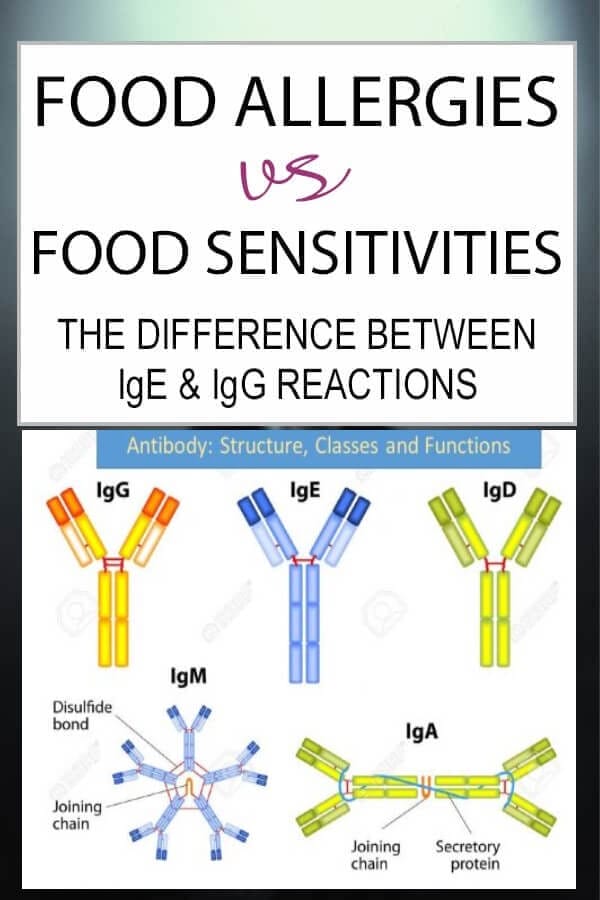IGG & IGE antibodies – what are the differences in food intolerances and how do we test for them?

IGG & IGE antibodies – what are the differences in food intolerances and how do we test for them?
IGG and IGE antibodies – what are the differences in food intolerances and how do we test for them?
Food intolerances and food allergies in Australia and worldwide and classes differently and have a range of different symptoms producing either IgG & IgE antibodies, There are a number of reasons why a food can cause health issues, the main two being a classic IgE food allergy (type I) and a delayed IgG food allergy (type III), which is also referred to as food intolerance.
In both type I and type III, the immune system is involved but the difference is in the way the immune system responds. Type III reactions are much more common but tend to be much milder and are often delayed and thus, more difficult to diagnose.
Functional Medicine health practitioners are experienced in testing, diagnosing, and creating treatment plans to help ensure you avoid the foods that trigger symptoms whilst also maintaining a healthy diet to support good health.
Antibodies
When your body detects harmful substances, (known as antigens), your body will produce an antibody, (known as immunoglobulin), which is a protein produced by the immune system. Antibodies attach to the antigens to destroy them.
The five major types of antibodies are IgA, IgG, IgM, IgE, and IgD antibodies:
IgA antibodies are found in areas of the body such the nose, breathing passages, digestive tract, ears, eyes, and vagina. IgA antibodies protect body surfaces that are exposed to outside foreign substances. This type of antibody is also found in saliva, tears, and blood. About 10% to 15% of the antibodies present in the body are IgA antibodies. A small number of people do not make IgA antibodies.
IgG antibodies are found in all body fluids. They are the smallest but most common antibody (75% to 80%) of all the antibodies in the body. IgG antibodies are very important in fighting bacterial and viral infections. IgG antibodies are the only type of antibody that can cross the placenta in a pregnant woman to help protect her baby (fetus).
IgM antibodies are the largest antibody. They are found in blood and lymph fluid and are the first type of antibody made in response to an infection. They also cause other immune system cells to destroy foreign substances. IgM antibodies are about 5% to 10% of all the antibodies in the body.
IgE antibodies are found in the lungs, skin, and mucous membranes. They cause the body to react against foreign substances such as pollen, fungus spores, and animal dander. They are involved in allergic reactions to milk, some medicines, and some poisons. IgE antibody levels are often high in people with allergies.
IgD antibodies are found in small amounts in the tissues that line the stomach or chest. How they work is not clear.[1]
The difference between a food sensitivity and a food allergy (IgG & IgE Antibodies)
In a true food allergy, a person’s immune system produces immunoglobulin E (IgE) antibodies in response to her consumption of a particular food. These IgE antibodies initiate a cascade of serious events. Food intolerances generally don’t trigger the dramatic or immediate reactions associated with food allergies, but they’re every bit as real. [2]
Classic IgE food allergy
In Australia, food allergy is estimated to affect 1-2% of adults and 4-8% of children under 5 years of age. Recent Australian data indicates that 10% of children aged under one year have a proven food allergy.[3]
Classic food allergies, such as a peanut allergy that causes one’s throat to swell, are mediated through IgE antibodies (immune globulins of the subclass E). When a person ingests the food to which they are allergic, IgE antibodies are created. The reaction is immediate, acute and can be severe. [4] Symptoms appear within seconds or minutes.
The most common food allergy signs and symptoms include:
- Tingling or itching in the mouth
- Hives, itching or eczema
- Swelling of the lips, face, tongue and throat or other parts of the body
- Wheezing, nasal congestion or trouble breathing
- Abdominal pain, diarrhea, nausea or vomiting
- Dizziness, lightheadedness or fainting [5]
In some people, a food allergy can trigger a severe allergic reaction called anaphylaxis, for which emergency treatment is critical. Anaphylaxis can be life threatening and can cause symptoms such as:
- abdominal pain
- anxiety
- confusion
- coughing
- rash
- slurred speech
- facial swelling
- trouble breathing
- low pulse
- wheezing
- difficulty swallowing
- itchy skin
- swelling in mouth and throat
- nausea
- shock [6]
The most common foods that trigger allergic reactions in childhood are egg, peanuts, tree nuts and cow’s milk and most children outgrow these allergies. Fish and shellfish allergies are most common in adulthood and less common are sesame, soy and wheat. Peanut, tree nut, sesame and seafood allergies usually last a person’s lifetime.
There’s usually no mistaking that a reaction occurred and what caused it so often blood testing is often only used to confirm the presence of this kind of allergy.
Food sensitivities or intolerances
A type III food allergy occurs when the immune system produces specific IgG antibodies (immune globulins of the subclass G). These antibodies can lead to inflammatory processes, with symptoms sometimes appearing up to three of four days after the consumption of a trigger food.
IgG antibodies do not produce the immediate histamine response associated with IgE antibodies. IgG reactions tend to be more subtle; headaches, bloating, fatigue, muscle aches or even cognitive dysfunction. Therefore, IgG reactions are often termed “food sensitivities” or “food intolerance.”
Food intolerances can be due to trouble digesting food, sometimes because of the lack of an enzyme needed to digest certain foods or as a reaction to additives or naturally occurring compounds in foods. [7]
People with these kinds of food sensitivities tend to have them to multiple different foods.
Common signs of a food sensitivity include:
- Fatigue
- Brain fog and difficulty concentrating
- Joint pain
- Headaches or migraines
- Eczema
- Rashes and skin irritations
- Stomach aches
- Acid reflux
- Bloating
- Constipation or diarrhea
- Unexplained weight gain or loss [8]
Common types of food sensitivities include wheat, gluten, dairy, corn and soy sensitivities.
Food intolerance, inflammation and chronic disease
When complex proteins are ingested, lactose and gluten especially, they break down in the digestive tract and form protein fragments. Recurrent exposures to unknown food triggers can inflame the gut, activate an immune response, and cause chronic underlying inflammation.
Intolerance to certain foods can trigger a wide range of chronic physical and emotional disorders including:
- Colitis (intestinal inflammation)
- Respiratory difficulty, asthma and chronic cough
- Atherosclerosis (heart disease)
- Rheumatoid arthritis – and stiff joints (e.g. back ache)
- Depression, anxiety, panic attacks
- Infertility and miscarriage
- Multiple sclerosis, epilepsy, neuro-muscular disorder
- Behavioural disorders in children
- Diabetes type 1 – and pancreatitis
- Thyroiditis – Graves’ Disease
- Hashimoto’s and other inflammatory disorders
Testing for food sensitivities or Food Allergies
As people can have sensitivities to a variety of foods, it can make them very difficult to pinpoint. By the time they’ve had the reaction, time has passed, and they’ve eaten many other things. And, it’s possible to have eaten other foods during that time are also causing a reaction.
The IgG Food Allergy Test helps to localise and limit the suspects, measuring the presence of IgG antibodies compared to specific food proteins. Your blood sample is introduced to protein extracts from each of the different foods If binding occurs between the antigen proteins and your IgG blood antibodies, it may mean that you will have a reaction to that food.
In conjunction with the IgG & IgE Antibodies Food Allergy Test, an elimination diet can discover food sensitivities by removing certain foods for a period of time and then slowly reintroducing them. It will reduce inflammation, give your gut a healing break, and will give you an insight into which foods cause a reaction for you.[9]
Following an elimination diet, a food rotation diet can also be helpful for reducing negative responses to foods. By eating from different food families over several days, existing food reactions can be reduced and the chance of developing additional food sensitivities can be lessened. As you remove the reactive foods from your diet, you’ll be able to observe changes in digestion, skin condition, energy level, or mood.
Typically, food families rotate every four days, but some instruct food rotation every seven, 14 or 30 days. Your Functional Medicine health practitioner can advise you on how long to follow your rotation diet and when to reintroduce foods. With some people, a number of months or more of food elimination may be necessary for IgG levels to become normal.
How our Functional Medicine Practitioners can help
The food we eat and the way in which we eat it has changed dramatically in recent years, and with these changes we’ve seen a rise in the number of people with food allergies and sensitivities. Although it’s difficult to pinpoint the exact cause, we can look at some factors including the rise of food additives, processed foods, pesticides, excessive antibiotic use, genetically modified foods and environmental toxins and chemicals
All these elements are likely to have disrupted our intestinal barriers and immune function. Testing for allergies and intolerances, enables us to change our diet, thus removing the cause of inflammation and let our body heal naturally.
At Advanced Functional Medicine, in addition to Advanced Gut testing, we can provide you with a food intolerance test performed by a finger prick blood test. Depending on the level of testing required, we measure 22, 132 or 176 foods, looking for reactive foods and chemical additives.
If you would like to book an initial consultation with one of our Functional Medicine health practitioners to determine which test is best for you, please fill out the form below or contact the clinic.




